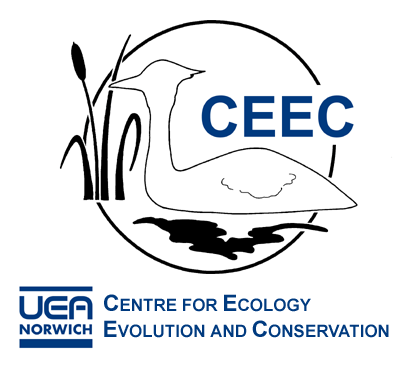Alastair Grant
Centre for Ecology, Evolution and Conservation (CEEC)
University of East Anglia

Alastair GrantCentre for Ecology, Evolution and Conservation (CEEC)University of East Anglia |
 |
I have been at the University of East Anglia (UEA) since 1989. Prior to that I worked in the Institute of Estuarine and Coastal Studies at Hull University, and Dove Marine Laboratory, Cullercoats (Newcastle University). I have a BSc in Marine Biology, and a PhD in Oceanography, both from the University of Wales (Swansea).
In addition to the research and teaching activities detailed below, I am Deputy Head of School and Director of Finance for the School of Environmental Sciences, overseeing the management of a £17M budget and am heavily involved with The Earth and Life System Alliance (ELSA), a strategic alliance between the University and the adjacent John Innes Centre. I have previously been director of the Centre for Ecology, Evolution and Conservation (CEEC), which brings together a large group of ecologists and evolutionary biologists spread across the Schools of Environmental Sciences and Biological Sciences..
Outside of work, I am married to Ruth, with a son and daughter aged 11 and 14, enjoy gardening and walking, and am a member of St Andrew's church in central Norwich.
The ultimate aim of my research in this are is to define the dose-effect relationships relating environmental concentrations of particular contaminants to predictions of their ecological effects. Within this, I have been particularly involved in the use of metal tolerant populations and communities as potential monitoring tools and as model systems to understand the cause-effect chain linking effects of contaminants on individual organisms to their ecological effects on populations and communities. This is increasingly involving me on work linking whole organism and population level effects with so called "biomarker" responses to pollutants. Other interests within this broad area include:
Environmental impacts of manufactured nanoparticles
Ecological risk assessment of drill cuttings piles and the likely environmental
impacts of oil rig decommissioning in the Northern North Sea
Use of X-ray fluorescence in monitoring metal concentrations and use of metals
as tracers of sediment transport.
Speciation and availability of metals bound to sediments.
For some additional internet based information see:
Summary of our work on environmental impacts of drill cuttings piles and links to other internet sites on platform decommissioning
Risks to the
environment from ivermectin use in marine fish farming.
In conjunction with Dr. Mark Rehfisch and Dr. Phil Atkinson of the British Trust for Ornithology (BTO), Dr. Steve Crooks and myself have been involved in carrying out a review for English Nature of the success (or otherwise) of schemes to create or recreate intertidal habitats such as saltmarshes and mudflats. The final report of this work is available on the English Nature web site, and further information on the project is available via this web page. One of my researchers, Hannah Mossman, is continuing this work, jointly supervised by a plant ecologist colleague, Tony Davy.
In November 2009, there were over 1700 citations of my papers in Science Citation index.
List of publications since 2000. A list of older publications is available here.
Marta Assunçao. Population level effects of endocrine disrupters on the stickleback, Gasterosteus aculeatus.
Jo Chitty. Ecological functions of created saltmarshes and mudflats.
Roger Dolorosa Conservation of the endangered marine gastropod, Trochus niloticus.
Robert Enever. Impacts of discarding on UK marine fish stocks (Based at CEFAS)
Widad Fadhullah. Impacts of low oxygen on marine ecosystem functions
Emmi Hall. Copper pollution and metal tolerant polychaetes: genomics and metabolomics
Asif Khattak Effects of temperature on growth in Arabidopsis thaliana
Dr Hannah Mossman. Can we successfully create saltmarshes and mudflats?
Sandra Santillan Hernandez. Impacts of pollutants on microbial communities.
Sandhya Sukumaran Population consequences of genotoxicity
Tom Turner. Meta-transcriptomic and population analysis of the community structure and metabolic response of microbes to different plant rhizospheres (based at John Innes Centre, supervised by Phil Poole)Oliver Wade. Influence of fishing gear design on discard rates in UK marine fisheries (Based at CEFAS)
PhD Opportunities
The School of Environmental Sciences has a number of PhD studentships available each year. I have a PhD project available with colleagues at the John Innes Centre carrying out mathematical modelling of the consequences of molecular processes for individual fitness and population dynamics (see here for details). For other research opportunities in Ecology, please look at the home page of the Centre for Ecology, Evolution and Conservation.
I have been course director for our Ecology degree programme, and had a major involvement in planning our MSc in Applied Ecology and Conservation, both of which are run jointly with the School of Biological Sciences. The course units that I teach are also available as part of our BSc Environmental Sciences programme, and have been course director for BSc Environmental Sciences with a year in Europe.
Professor Alastair Grant
School of Environmental Sciences,
University
of East Anglia,
Norwich, NR4 7TJ, U.K.
Tel +44 (0)1603 592537 FAX +44 (0)1603 507719 e-mail A.Grant@uea.ac.uk

 More general
information on Ecology at UEA
More general
information on Ecology at UEAThis page was last updated on 30 January, 2008